20 years after Bush won Nevada, should Republicans look to 2004 for presidential roadmap?
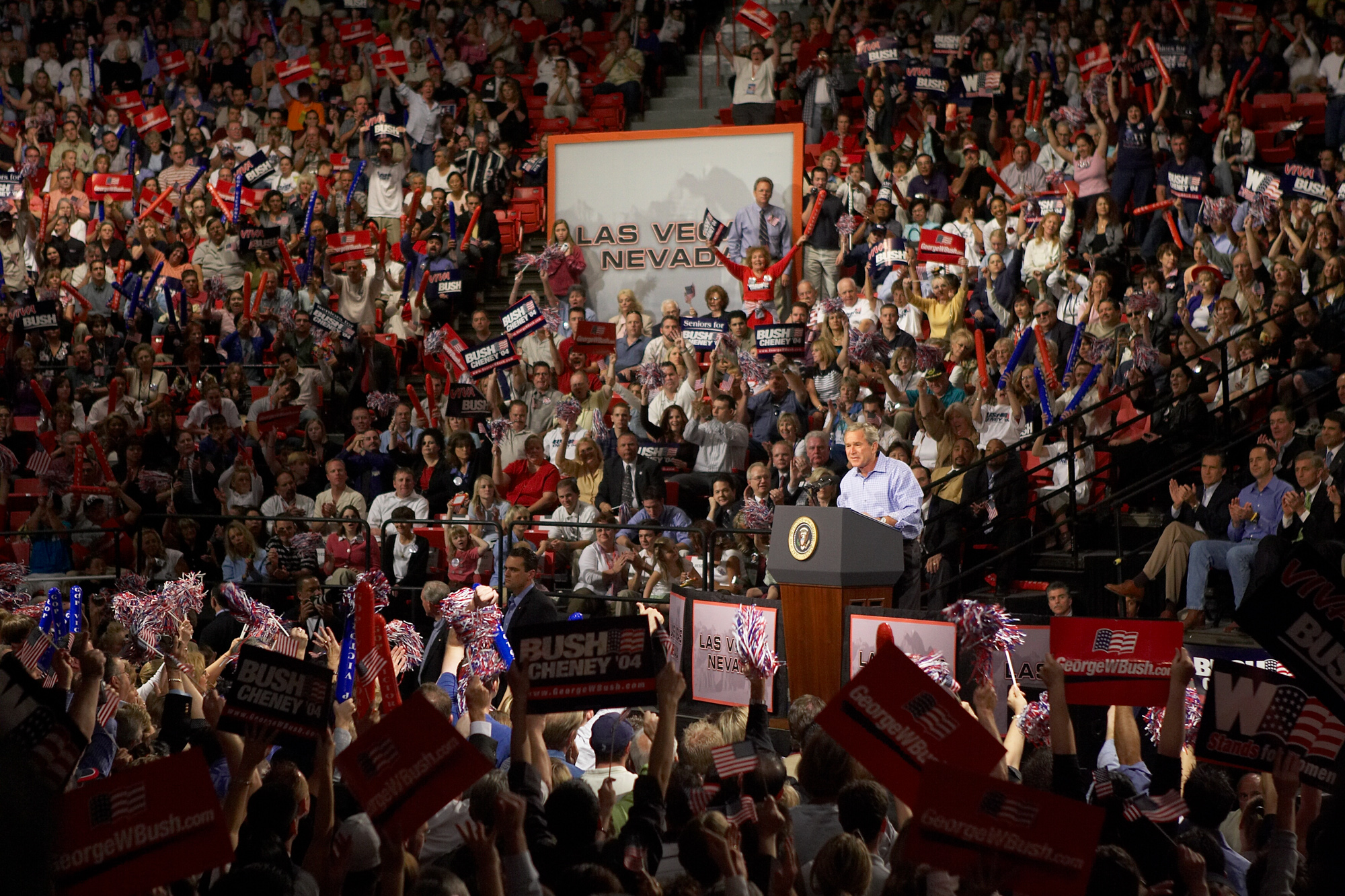
It was Nov. 2, 2004, and Scott Stewart had just heard the three words that sent his stomach into knots:
“Hold for Karl.”
Stewart was the Nevada state director for then-President George W. Bush’s re-election campaign. He was sitting in the campaign’s war room in Reno and Bush campaign manager Karl Rove was on the phone. It was 11 p.m. on election night, and Bush was sitting at 269 electoral votes — one state away from a second term.
Rove, the famed architect of Bush’s political ambitions and who grew up in Sparks, wanted to know why votes from Nevada’s rural counties — where Bush was expected to pull ahead — had not yet come in.
“I said, ‘Don’t worry,’” Stewart said. “‘Everything is going to be just fine. All my models show that we’re going to win by about 20,000 votes.’”
Rove was not impressed.
“Rove says, ‘Scott, I really don’t give a crap about your models,’” Stewart recalled. “‘I’m sitting with the president and we’d like to see the votes. Why don’t you send some field representatives to make sure they’re not stealing this thing from us?’”
As Tuesday turned into Wednesday, Stewart dragged “half-drunk kids” out of campaign parties in Reno and sent them out to county clerks’ offices to check in on the vote counting.
The night went on, with Democrat John Kerry winning Hawaii, Michigan and Minnesota. But it wasn’t enough. By 8 a.m. in Nevada, the writing was on the wall. Kerry called Bush to concede — half an hour later, the rural votes came in. Stewart’s model had been right. Bush won Nevada by 21,500 votes.
The Nevada call made it official — Bush had surpassed 270 electoral votes and won re-election. Stewart and the other GOP operatives who had made it their mission to keep Nevada in the Republican win column over the past year rejoiced.
It would be the last time in two decades that a Republican presidential campaign in Nevada would celebrate the call.
Four years later in 2008, Barack Obama rewrote the possibilities for a Democrat in Nevada, improving on Kerry’s vote total by more than 130,000 votes en route to a 12.5-point drubbing over Republican John McCain — the state’s largest presidential margin of victory in the past 40 years and the first time since Lyndon B. Johnson in 1964 that a Democrat won a majority of votes in the state. (Bill Clinton won the state twice with a plurality.)
2008 was not a one-cycle fluke for Democrats. Obama won the state again in 2012 by a narrower seven points. Hillary Clinton won Nevada by an even slimmer 2.42 percent margin over Donald Trump in 2016. Joe Biden in 2020 smashed prior turnout records to win over 700,000 votes in Nevada, nearly replicating Clinton’s margin (2.39 percent) over Trump.
Neither Bush’s 2004 win nor the long string of Democratic victories that followed were inevitable. Strategists and political experts said a combination of an impressive data operation, successful voter registration strategies, get-out-the-vote efforts and a national mood that favored Bush powered Republicans’ success in the 2004 campaign.
But the year also marked the first electoral triumph of the vaunted Reid Machine, with then-Sen. Harry Reid (D-NV), having dedicated himself to rebuilding the state party and his own margins of victory, winning re-election by 25 points over an anti-gay marriage activist opponent — both portending how a Democratic rebuild cemented a generation of electoral strength in Nevada and how Republicans could be brought down by their right wing.
Nevada’s electorate has undergone massive shifts over the nearly 20 years that followed — economic turmoil during Bush’s second term, population growth and massive demographic changes in becoming a majority-minority state, growth in the number of nonpartisan voters and a shift in voter priorities away from the foreign-policy-dominated 2004 election.
“It’s party functionality meets demographic change meets opportunity,” said David Damore, a political science professor at UNLV, of Democrats’ four consecutive presidential victories.
The war in Iraq and terrorism no longer top the list of voter concerns, and the Nevada electorate that will go to the polls in 2024 looks very different from the one that delivered Bush victory 20 years ago.
But strategists say candidates can still learn from those days.
“If you're going to be a conservative, be a compassionate conservative,” longtime Republican strategist Pete Ernaut said in an interview. “They sort of lost that first word for a long time, and now it's starting to come back.”
“I just don't think that the Kerry campaign could compete”
Going into 2004, Nevada had a strong history of picking presidential winners. Beginning with Franklin D. Roosevelt in 1932, Nevadans had voted for the winning presidential candidate in every election save 1976. Though small, it had become a swing state by 1992 — voting for Bill Clinton in both of his campaigns before Bush won the 2000 election in the state by about 3.5 points.
Democrats, having lost the controversial 2000 election, pursued a new strategy. Al Gore, despite being from Tennessee, had lost every Southern state; Kerry, the first non-Southener to win the Democratic nomination in 16 years, had a bold new plan. The South was a lost cause — so he put his focus on the Southwest. Flipping a state such as Nevada, with a newly minted five electoral votes, could be the difference in a close election.
Kerry made Nevada a priority, visiting Las Vegas and Reno six times compared to Bush’s three visits.
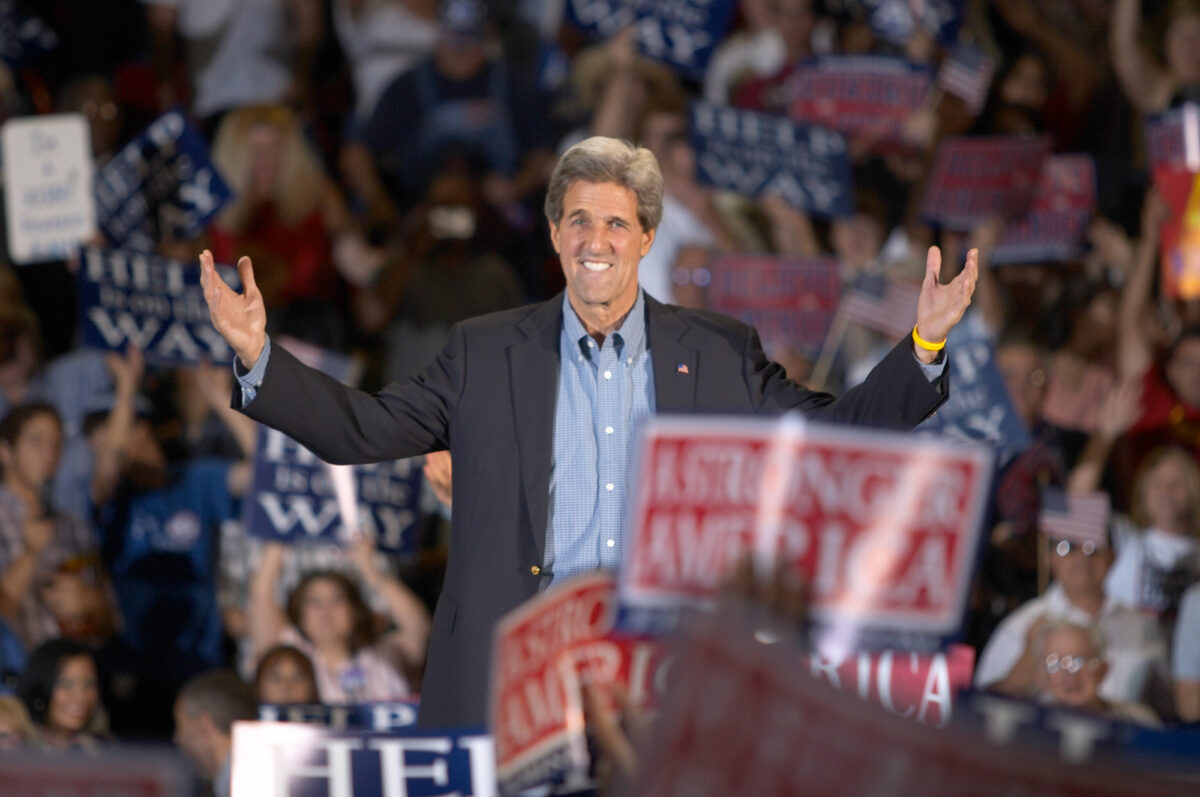
Chris Carr, a longtime Republican operative with stints working for Trump and the Republican National Committee, was the executive director for the Nevada GOP at the time. He knew the Kerry campaign was playing to win in Nevada and, in June, he was busy preparing for Bush’s first event in the state — a rally in Reno — when he got a call from a reporter asking if he had seen the latest voter registration numbers.
Republicans had started 2004 with a 13,000-person advantage over registered Democrats; by June, that advantage had shrunk to about 8,500. By July, Republicans’ lead had evaporated to just 1,500.
Carr told the reporter he was busy, and then quickly called the party’s data staffers, who confirmed the bad news.
“The state had always been, in the '90s, majority Republican, but it wasn't much — it was 10,000 [or] 15,000,” Carr said. “It was always within striking distance for the Democrats. Well, guess what? They struck.”
Before long, he was fielding calls on how to get the advantage back. Democrats, exercising the might of allies including the Culinary Union, progressive advocacy organizations and aligned interest groups, had gone all in on the strategy to close the registration gap.
To defeat the newly assembled registration army, Carr said he had to learn on the job. It helped that the Bush campaign put numerous resources behind the effort, building out coalitions targeting everyone from veterans to Hispanics to “national security moms.” It was buoyed by what Carr, a veteran of three decades’ worth of campaigns, called the “most robust volunteer operation” he had ever been involved in.
Stewart, the state director, said the Bush campaign ultimately recruited about 14,000 volunteers who, in turn, made about 1 million contacts with voters, operating under the theory that the campaign that brought more partisans out to the polls would win.
“We had really, really good, granular microtargeting data about who was a Republican that was masquerading as an independent,” Stewart said. “We were able to find all those folks through the microtargeting game that we had, and then we knocked doors and we talked to voters.”
Carr said Republicans tailored messages to three main demographic groups — rural Nevadans, who they targeted with gun rights and mining-based messages, fiscal conservatives in Washoe County, and swingy voters in Clark County, from Midwest retirees to mothers worried about terrorism.
“We were targeting groups of 150, 300, 500 voters with very specific messages tailored to them,” Stewart said. “And I just don't think that the Kerry campaign could compete.”
Stewart said the campaign made phone calls and knocked on doors in the rurals with a message about the Healthy Forests Initiative; Carr added that the campaign worked with mining companies on voter registration.
Kerry’s campaign focused on Washoe County; conversely, Carr said Republicans worked to squeeze as many rural votes as possible while narrowing the margins in Clark County. The strategy worked — Kerry closed the gap in Washoe (improving on Gore’s margin by about 5 points) but still lost the county. Meanwhile, Bush improved his margin by about 1.5 points in populous Clark County — still losing the county but gaining over 84,000 votes from his previous campaign.
Las Vegas was booming in the early 2000s, so when a field staffer suggested to Carr that they throw block parties in new developments — replete with hot dogs and face paint — he was thrilled with the idea. At the events, Bush campaign volunteers would walk around with petitions on friendly issues, such as taxes, and take the opportunity to register the new arrivals to vote. The party also purchased lists of new homes from data vendors and sent mailers with a welcome message from popular Republican then-Gov. Kenny Guinn, generating more new registrations.
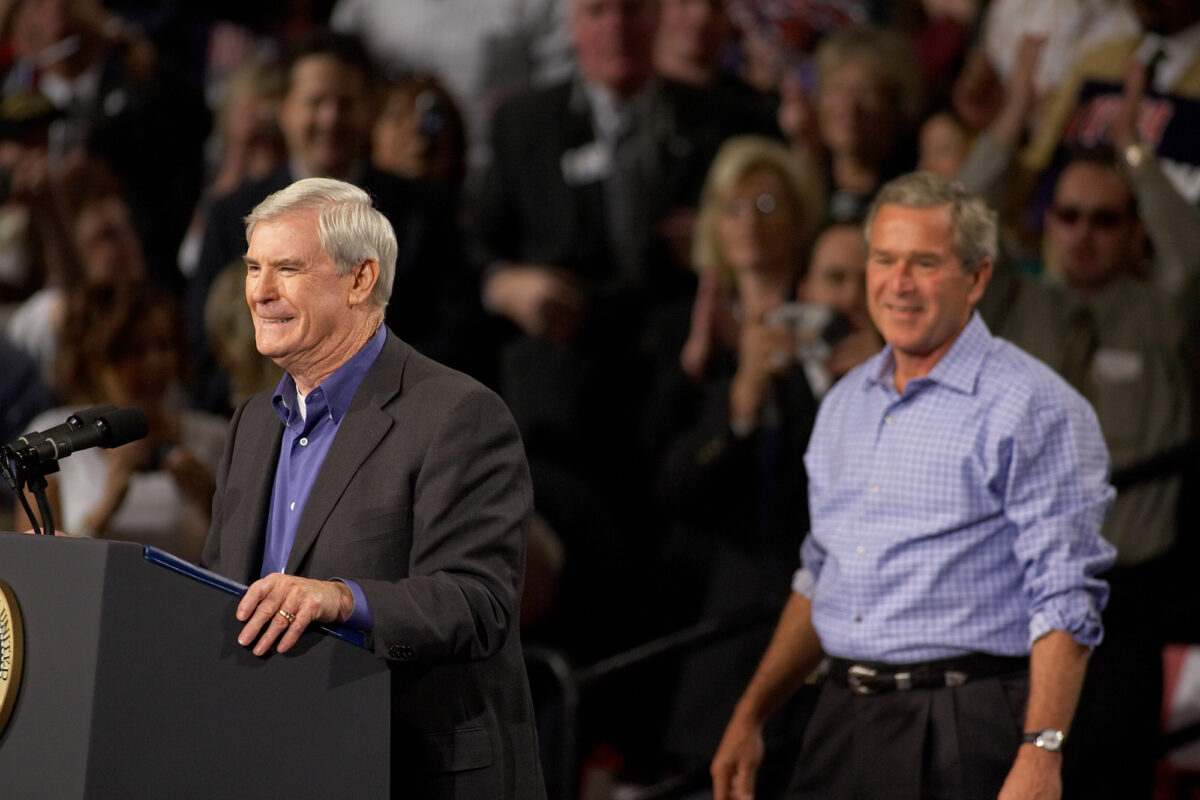
The Bush campaign nationally knew it was winning with voters who cared about “moral issues” and national security. While moral issues may seem contradictory to Sin City, Carr said the campaign made inroads with churches while Stewart said it helped weaken Democrats’ margins with Hispanic voters — a key goal of Rove. (Bush won nearly 40 percent of the state’s Latino vote; by comparison, Mitt Romney won 25 percent in 2012, and Trump got closest in 2020 with 35 percent.) It helped that Bush, a former governor of Texas, spoke some Spanish and believed in comprehensive immigration reform.
“Bush was well ahead of his time in terms of appealing to Hispanic voters,” Ernaut said. “Republicans made huge inroads in that era because of it.”
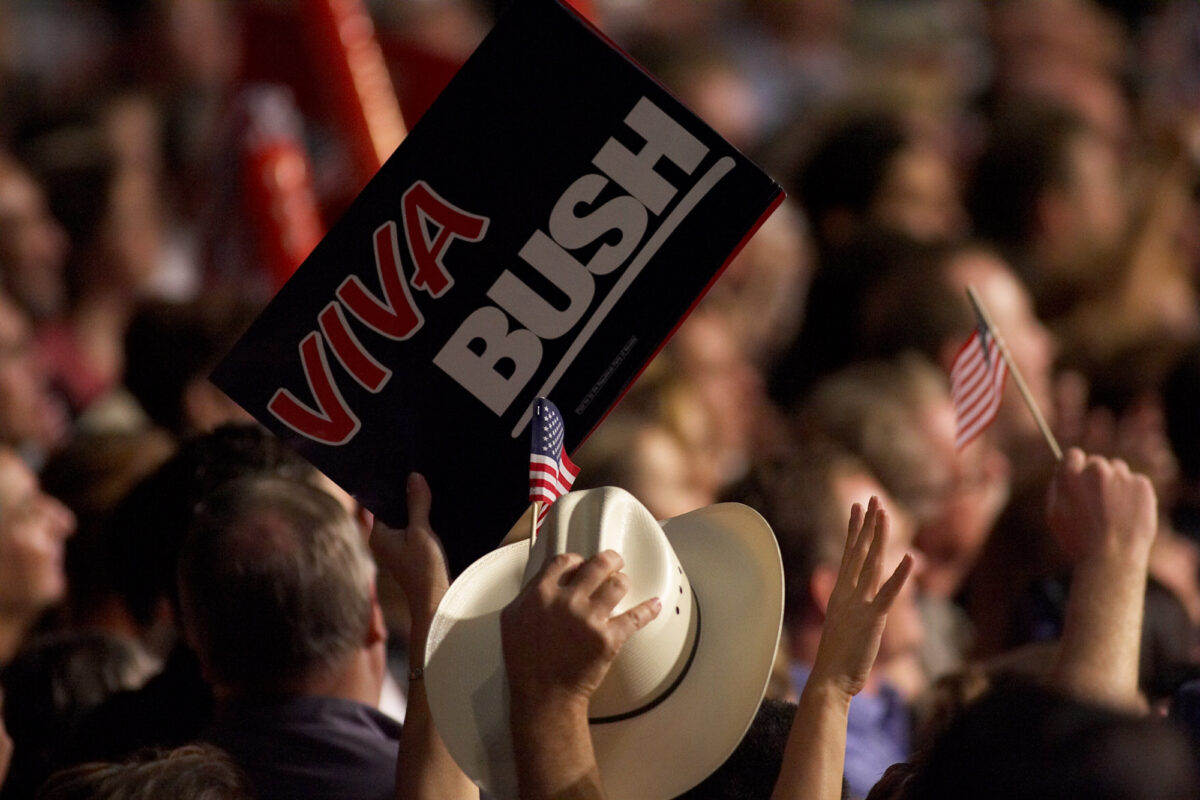
And in the post-9/11 landscape, the issue of terrorism won over many swing voters. Of the 25 percent of Nevada voters who said terrorism was their top issue — the most frequently named issue among voters — 88 percent cast ballots for Bush, per exit polls.
Kerry made a play in August attacking Bush over his administration’s efforts to store nuclear waste at Yucca Mountain. But using the Rove-ian method of turning his candidate’s weakness into a problem for the opponent, Bush operatives painted Kerry as a flip-flopper on the issue, saying he had previously supported storing waste in the state. It was an unfounded attack; as a senator, Kerry had a record dating back to 1987 of voting against the repository’s creation. But when then-Vice President Dick Cheney held a September rally in Las Vegas, supporters chanted “Flip-flop! Flip-flop!” five times throughout the speech, including during a section on Yucca.
Carr said the state party spent over a year training a “72-Hour Task Force,” whose goal was to get out the vote in the three days leading up to the election and take advantage of early voting. When he saw a van full of Kerry volunteers knocking on doors, he said he could tell the scale of their operations were different — and he felt confident Bush would win.
Though the margin was smaller than in 2000, Bush beat Kerry by about 2.5 points in Nevada. Strategists say it came down to turnout.
“We had a much bigger get-out-the-vote operation than what Kerry had,” Carr said.
Laying the foundation
While Democrats may not have won the presidential race in 2004, leading Democrats began meticulously planting the seeds for future success.
Reid narrowly won his Senate re-election campaign in 1998, Gore lost the state in 2000, and by the 2002 midterms Democrats had cratered — losing every statewide race including the newly created 3rd Congressional District in the Las Vegas suburbs.
With an eye toward 2004, Reid set about rebuilding the state party and coordinating a network of Democrat-aligned interest groups, including organized labor groups such as the Culinary Union. He hired Rebecca Lambe, a veteran of Democratic politics in Missouri, as the state party’s executive director, and committed himself to fundraising.
Lambe declined an on-the-record interview, but said in a statement that in 2004, the party “started making smart investments in the political infrastructure needed to win, we began to change the electoral math in the state through voter registration and persuasion” and focused on expanding access to voting.
“We didn’t win the presidential race that year, but we laid the foundation for a durable Democratic advantage in Nevada over the past two decades,” Lambe said in a statement to The Nevada Independent.
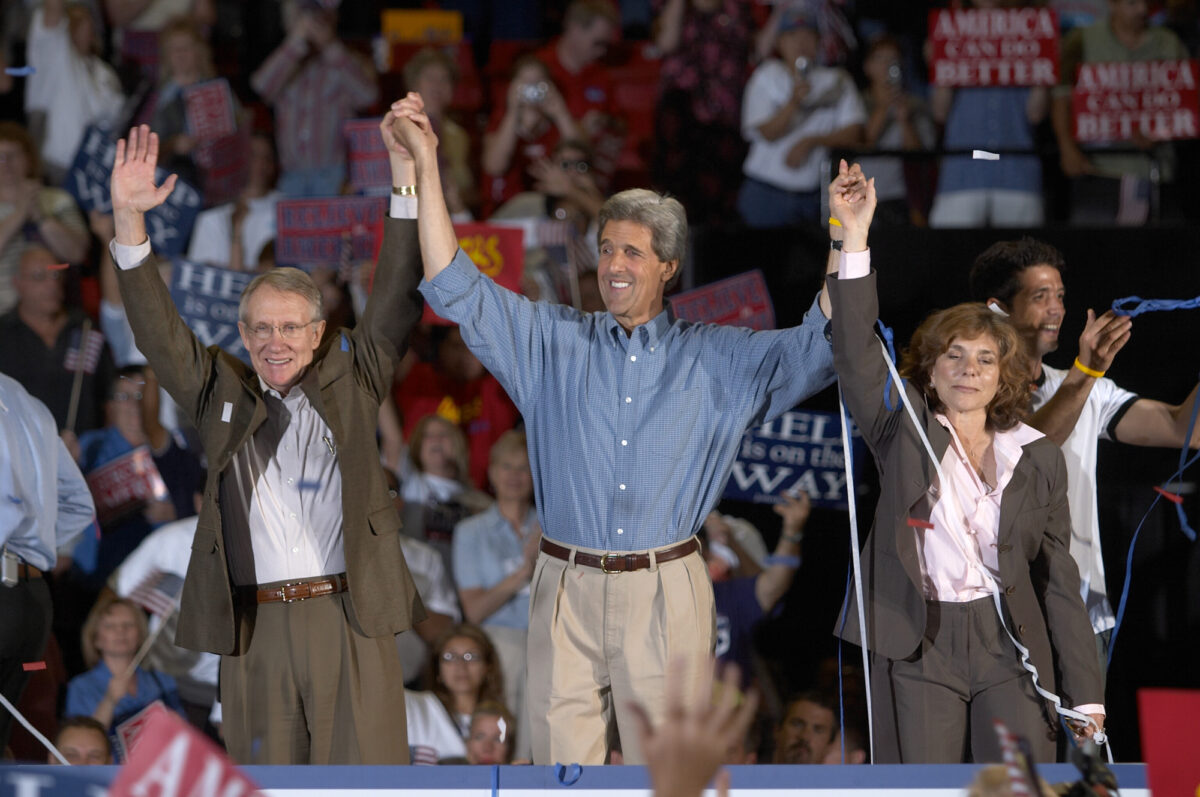
The state party committed itself to those initiatives. First, it invested in human capital and resources — data, staff, research. Secondly, operatives believed Nevada’s partisan lean was ripe for change through a renewed focus on voter registration efforts, activating an under-registered Hispanic population, making Washoe more competitive, and building an advantage in Clark County that would make it difficult for Republicans to overcome. Thirdly, they wanted to expand access to voting, convinced that high turnout would benefit Democrats.
Democrats’ turnout operation also benefited from a built-in efficiency, Damore said, because they can bypass rural counties.
“[One] real advantage for Democrats in Nevada is the scale of the urban counties,” he said. “They can essentially put the resources in two places.”
In 2004, though Democrats lost the presidential race, Reid won re-election in a landslide over Richard Ziser, an anti-gay marriage and anti-abortion activist. In the 2006 midterms, Republicans maintained control of the state’s other U.S. Senate seat and governor’s office, but lost other down-ballot statewide races.
By 2008, Reid and Lambe’s party-building efforts coincided with another political phenomenon — Obama.
Democrats overtook Republicans in voter registration by 2008 and (encouraged by Reid) moved their presidential caucus up to February. The Obama effect was instant — and devastating, for Republicans. At the caucus, Democrats registered 30,000 voters in 90 minutes.
Carr recalled walking around Reno in 2007 and seeing eager Obama volunteers already doing voter registration.
“I knew then,” he said. “I was like oh, boy. We’re gonna get our butts kicked.”
Republicans and Democrats alike describe Obama’s 2008 campaign as markedly different from the typical election cycle.
As the focus of his Nevada operation, Kerry cut Washoe to a 4-point deficit; Obama won it by 13 points. If Republican opponent John McCain expected a boost in Clark County due to his longtime stature in neighboring Arizona, he was sorely mistaken. Obama won Clark by almost 20 points, just four years after Bush had cut the margin to less than 5 points. Even Carson City, which had not gone for a Democrat since 1964, landed in Obama’s win column.
“Obama, the first time around, had the crazy enthusiasm of people just tripping over themselves to volunteer and be involved,” Stewart said. “When you have people who are going up to the campaign headquarters and saying, ‘I’ll do anything for this person’, that’s pretty easy to work with.”
Stewart said Obama’s 2012 re-election campaign was similar to Bush’s 2004 campaign — neither president was overly popular and faced a sluggish economy, but grinded out a win thanks to a superior turnout operation.
“They found all their partisans, with a much bigger organization and much better data than their opponents,” Stewart said. “We broke the Democrats’ hearts in 2004, and they broke ours in 2012.”
A changing Nevada, and lessons for the future
Though the 2016 and 2020 elections were closer, Democrats were still able to win on the strength of their organizing, experts said, even in years such as 2020 when Damore said Democrats came out “flat-footed” and had to play catch-up when Trump and the RNC invested major resources. The GOP had been catching up heading into the 2020 election, but the state’s 2018 automatic voter registration law and a growing number of Nevadans identifying as nonpartisan has halted that momentum.
Democrats have had their share of ideological disagreements — including the 2021 takeover of the state party by the Bernie Sanders-aligned left. But the Reid Machine has managed to paper over those differences effectively during elections, including in 2022 when state Democrats defied expectations of a midterm blowout and defended several key incumbents, including all three Democrats in the state’s House delegation and Sen. Catherine Cortez Masto’s seat.
On the right, it’s been a different story.
Starting in the 2008 election, the insurgent libertarian faction backing Ron Paul’s presidential run began organizing and eventually took over the state party by 2012, causing a long-lasting schism. Using extensive knowledge of party rules, Paul’s followers systemically overtook county parties, giving them control over the delegate selection process and allowing them to chase the old Bush-era guard away. Establishment Republicans set up a shadow organization to support Romney; unlike the Reid Machine, they never took the state party — or the body politic — back.
“[Between] the Ron Paul takeover of various different party structures around the country, and then in the Trump era, you have a lot of nasty infighting within party structures,” Stewart said.
While presidential campaigns have their own superstructures, a highly ideological state party can scare away people who may have been volunteers in the Bush era and help contribute to poor down-ballot candidate quality.
For example, Stewart said that in 2004, he blocked rural Assemblywoman Sharron Angle from attending Bush events: “She was so crazy!”
But bolstered by the Tea Party movement — and some meddling from Reid — Angle ended up as the Republican nominee for Senate in 2010, losing an eminently winnable race.
“You started seeing this much more activist component of the Republican Party, and there isn't anybody that's sort of brokering this like Reid does on the Democratic side,” Damore said. “So, they end up sort of getting to this point where the tail starts wagging the dog in terms of party operation, in terms of nominations.”
Beyond the parties, Nevada’s population has also grown dramatically, with over 800,000 more people living in the state today than did in 2004. Population growth and growing polarization have disrupted the prior cozy political culture that often elevated moderate Republicans like Guinn, who were comfortable working with members of both parties.
And newcomers to Nevada overwhelmingly come from one place.
“Nevada has changed dramatically in the last 20 years, and one word describes it: California,” Stewart said.
Northern Californians have moved to the Reno-Tahoe area; Inland Empire types and Angelenos have moved to Las Vegas. Strategists said given their socially liberal nature, this migration has benefitted Democrats; however, Republicans noted that, particularly for those coming from the Inland Empire, there is room to grow their voter population among the transplants.
Rep. Mark Amodei (R-NV), the state’s lone federally elected Republican, said the party needs to capitalize on those voters to be more competitive in the state.
“They didn't leave California and come to Nevada because California wasn't liberal enough,” he said.
In the 20 years since 2004, Nevada’s population has become majority-minority. The demographic intangibles, Damore said, could in theory be advantageous for Republicans. Nevada’s population is among the least college-educated in the country, a key group for Republicans that have powered their victories in states with similar education rates including Oklahoma, Alabama and Kentucky. But Nevada’s high degree of urbanization, union participation and plurality of racial minorities all benefit Democrats.
Though Nevada is different, strategists say the formula for a Republican presidential candidate to win statewide might involve dusting off the Bush playbook: Get a candidate with broad appeal through the primary, keep the margins relatively tight in Clark County and drive the Hispanic vote percent closer to the 40 percent that Bush won.
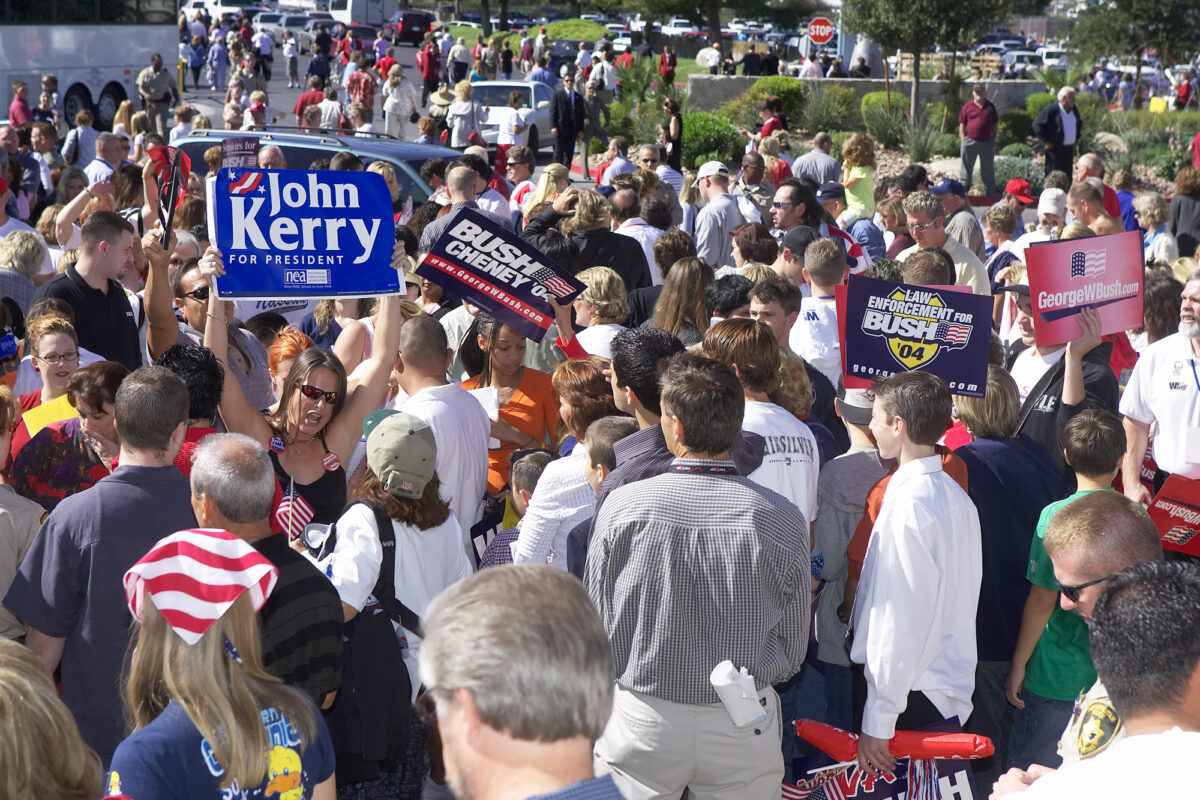
Strategists said a successful Republican needs to play to the middle.
“[Bush] was a compassionate conservative — a more moderate social agenda, and a more conservative fiscal agenda,” Ernaut said. “Whether it was Kenny Guinn or Brian Sandoval... they sort of fit that mold.
“The electorate, although re-formed, is becoming very similar.”
